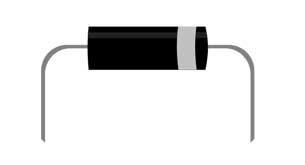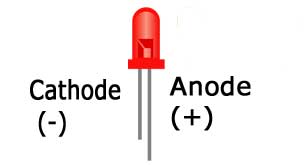Facts about Diodes
Posted by Admin / in Science Facts

A typical diode
Diode Facts
Learn facts about diodes, one of the most useful electronic components used in circuits. Diodes have many uses in circuits from converting AC to DC to helping to convert sunlight to electricity. Learn more about these incredible useful components with more facts about diodes.
- A diode is an electronic component that only allows current to flow in one direction.
- Since electricity can only flow in one direction through a diode they must be connected correctly. Electrical current flows from the cathode side of a diode to the anode side. Generally the cathode side is connected to the negative side of a DC power supply. A diode has a black band marking the cathode side.
- A diode is made by applying some p-type silicon on a plate made of n-type silicon. P-type silicon is made with boron atoms, creating a "hole" connecting the silicon atoms together. This hole will accept an electron. N-type silicon is made with phosphorous atoms with the silicon atoms. Phosphorus atoms have 5 electrons (one extra), which allows current to flow when the extra electron fills the hole in the p-type silicon.
- Diodes typically require a minimum amount of voltage for the current to flow through them. Manufacturers provide this minimum voltage amount with diodes they sell. Most standard silicon diodes require at least 0.6 volts for current to pass.
- Diodes are used to make a radar detector.
- Diodes are used to make a solar cell.
- There are different kinds of diodes available. Some of the major types of diodes include light-emitting diodes (LEDs), Zener diodes, small signal diodes, power rectifiers, and photodiodes.
- Photodiodes are very useful electronic components. Photodiodes can act as a switch in a circuit or provide a small amount of current to a circuit. When enough light is provided to a photodiode, current is allowed to flow through the circuit.
- Diodes were originally known as rectifiers. Today one type of diode, known as the power rectifier, is used to make power supplies for electronics.
- A Zener diode, invented by Melvin Zener, is a special diode that is used as a voltage regulator. It can allow current to flow in both directions when enough voltage is present.
- A small signal diode can perform a number of functions such as detections of radio waves and conversion of low current AC to DC.
- Schottky diodes use a metal and semiconductor connection instead of a semiconductor to semiconductor connection. Schottky diodes switch much master at a lower voltage (as low at 0.15 volts). Schottky diodes allow electrical engineers to create more efficient circuits.
Facts about the History of Diodes
It was a long process for devlopment of the diode. There were several early inventors who were ahead of their time predicting the need for a diode. At the time, however, these inventors did not understand how semiconductor materials worked. Here is some of the early history of diodes.
- A German scientist named Ferdinand Braun noticed that current would only flow in one direction when experimenting with lead sulfide and metal wire in 1874.
- Thomas Edison's group noticed one-way flow of current by accident while inventing the light bulb in 1883. They named the phenomena the Edison effect.
- In 1886 an inventor named C.E. Fitts built a rectifier using selenium, which only allowed current to flow in one direction.
- In 1938 Walter Schottky developed the concept for his Schottky diode.
- In 1940 Russell Ohl, who worked at Bell Labs, discovered that diodes were capable of generating electricity when exposed to light.
- The first patent for LEDs was issued to James Biard and Gary Pittman while working at Texas Instrument in 1961.

A LED (light emitting diode) is a type of diode
